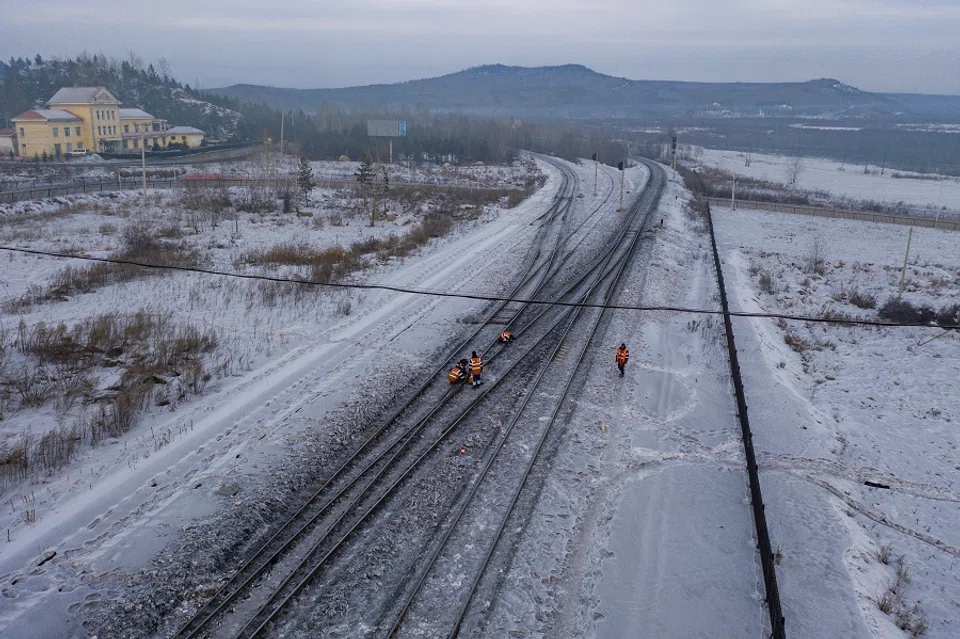Why China's railway development has fallen short of Sun Yat-sen's expectations
While China has soared ahead in other areas such as expressway construction and port development, it lags behind heavyweights like the US in railway development. A fundamental cause is relying on the government as its single investment channel. Plugging its railway gaps, literally and figuratively, would give China's economic development a decided boost.

Aside from being a famed revolutionary, Sun Yat-sen had a remarkable vision for China's development. In finding ways for the country to overcome adversity and survive, Sun came to the conclusion that China had to industrialise. Among the various forms of industrialisation, Sun was particularly fond of railway construction. In the second volume of his definitive work on nation-building, Jianguo Fanglue (《建国方略》), he detailed his proposal for industrialisation and explained his thinking behind his railway plan.
Sun believed that if transportation is the mother of industrialisation, then the railway is the mother of transportation. At that time, he was already convinced that China had to build 100,000 miles (or 160,000 km) of railroad and one million miles of road (the idea of a "road" at that time was only in terms of pavements). But China's railway construction was in its infancy, and it was only 9,400 km long. Building 160,000 km of railroad was clearly an extremely ambitious and even outlandish goal back then. But Sun not only wrote it down in paper, but practised what he preached.
Railway development has grown by leaps and bounds
45 days into his position as the provisional president of the Republic of China, Sun was forced to resign. Later, he requested to chair the China Railway Corporation (中华民国铁道协会) and oversaw the construction of railways in China in this capacity. He envisioned the building of six major railway systems in China, or 106 lines and 77,850 miles of railway tracks. But back in the Warlord Era where the country was in chaos and the people in turmoil, this grandiose plan was doomed to fail.
Based on the current construction speed, China is expected to exceed 160,000 km of railway tracks in 2023, finally fulfilling the vision of the pioneer of China's revolution.

A full century later, China is still some way off from fulfilling Sun's goal. As of 1949 when the People's Republic of China was founded, China only had 23,000 km of railway tracks. Following the founding of New China, due to weak national strength and mistakes in the process of developing the nation, until the eve of reform and opening up in 1978, China's railway tracks only spanned 51,700 km.
After over 40 years of rapid development, China's railway construction has clearly grown by leaps and bounds. As of the end of 2020, China has 146,000 km of railway tracks. Based on the current construction speed, China is expected to exceed 160,000 km of railway tracks in 2023, finally fulfilling the vision of the pioneer of China's revolution.
The US built its first railroad in 1830. But within a span of 60 years from 1850 to 1910, it had already constructed 370,000 km of railroad, primarily driven by westward expansion.
From a vertical perspective of its trajectory, Chinese railway builders can be deeply satisfied with their current accomplishments. From a horizontal perspective, however, compared with other nations, particularly the top railway power of the US, China's railway construction standards still have much room for improvement.
The US built its first railroad in 1830. But within a span of 60 years from 1850 to 1910, it had already constructed 370,000 km of railroad, primarily driven by westward expansion. During this period, it once constructed over 10,000 km of railroad every year for more than ten consecutive years. When railway construction was at its peak in 1880, the US's steel production was only around 1.25 million tons. As for the US's overall strength, its GDP was a mere US$20.6 billion in 1900, or what is equivalent to only half a day's output in China today.

However, the US rose to become the world's top railway power (excluding high-speed rail) in spite of its insignificant national strength back then, and has maintained this position until today, with no competition from any other country. While China has ramped up railway construction in recent years, it merely added 9,000 km of railway tracks in 2015, at the peak of its construction. In the 1980s and early 1990s of the last century, only a few hundred kilometres of railway tracks were built in China every year. In 1991, this number was even reduced by 100 km, illustrating the great difficulty in China's railway construction.
Only behind in rail
As a result of China's continued rapid growth since reform and opening up, China has made great progress in various fields. For example, while China only built its first expressway in 1988 (the US built its first in 1937), it surpassed the US to become the world's largest national expressway network in 2014, and continues to expand its lead today. China's roads span over five million kilometres long, exceeding Sun's envisioned goal by three times or more. The standard of China's roads also far exceeds Sun's imagination.
The fundamental reason for China's unsatisfactory railway construction speed is due to its single investment channel of entirely relying on government funding.

The same can be said of China's ports. The container throughput of the Port of Shanghai accounts for one-tenth that of the world's. Also, China has surpassed the US to become the world's largest electricity producer. China is only lagging far behind the US in terms of railway construction. Early in 1916, the US's railroads had already reached its peak of 408,745 km. Thus, a century later, the length of China's railway tracks is only one-third of the US's back then. Following the unprecedented popularisation of automobiles and the development of the aviation industry, railway construction went downhill and some railway tracks were either abandoned or demolished one after another. However, 260,000 km of the US's railways are still in operation today.
The curse of government funds as the single channel of investment
The fundamental reason for China's unsatisfactory railway construction speed is due to its single investment channel of entirely relying on government funding. Although China's taxes have increased substantially over the years, there are too many other areas that also require financial resources, such as education, healthcare, poverty alleviation, pension, technology, national defence, diplomacy, and so on. Thus, government investment in railway construction has been below expectations.
On the other hand, the reason why China's expressways have developed so rapidly is because of the large amount of private investments, and the reason why private investments are so enthusiastic in this industry is because their investments can be recovered by collecting tolls. However, private investors are not keen on investing in railway construction because it is impossible for investors to control the operation of railroads - regardless of the amount of investment, the railroads are centrally operated by China Railway (formerly known as the Ministry of Railways). It is impossible for the railways to be operated independently and from multiple ends - this would inevitably cause chaos in railway transportation and pose accident risks. Since operations cannot be controlled, it becomes hard to expect a return on investment. Thus, private investors are uninterested in railway construction. With only a single channel of investment, it is obvious that the speed of railroad construction would be restricted.
As train tickets are in such high demand, ticket touts (what the Chinese call huang niu (黄牛, lit. yellow cow)) and even criminals across the country who forge train tickets would spring into action during this period...

With an incomplete railway network and many gaps to fill, a lack of transport capacity has become a major shortcoming restricting China's development. Following years of rapid economic growth, the vast majority of China's manufactured products are in oversupply. Not rail transport, however, which is in short supply especially during the Chinese New Year period, when large numbers of migrant workers return home. During the festive season, train tickets are so hard to come by that China has a term for this tense situation: Chunyun (春运), or the Spring Festival travel rush. Since seats are quickly snatched up, many passengers are left with standing tickets and have to endure the long and arduous journey standing in a packed train.
As train tickets are in such high demand, ticket touts (what the Chinese call huang niu (黄牛, lit. yellow cow)) and even criminals across the country who forge train tickets would spring into action during this period, inviting much displeasure from travellers. Special teams in the police force are even set up during this period to crack down on these "yellow cows". Before selling tickets online became common, the tickets were sold in temporary marketplaces such as stadiums. But ticket buyers would often fail to buy a ticket even after queueing overnight.

Now that tickets are sold online, train tickets are often gone in seconds during the Chunyun period. People have even created "ticket-snatching software" to increase their chances of securing a ticket. Although new high-speed rail lines are constantly put into operation and help to ease the shortage of train tickets slightly, the train ticket frenzy during the Spring Festival is still not completely eradicated.
While China's railway construction has made remarkable progress in recent years, China's population size of 1.4 billion implies that each person is only entitled to 10 cm or a cigarette length of railroad on average.
While China's railway construction has made remarkable progress in recent years, China's population size of 1.4 billion implies that each person is only entitled to 10 cm or a cigarette length of railway on average. This is certainly far from sufficient.
China's railway development - still some ways to go
Based on this index alone, China is ranked relatively low among other countries in the world. Although China's recent high-speed rail construction is impressive, it still lags far behind in terms of overall railway development. This is first seen in the incomplete rail network. For example, there are millions of square kilometres of gaps yet to be filled on both sides of the Qinghai-Tibet railway alone. Next, there is also much room for improvement with regards to the standard of railway development: many lines are still one-way, and the proportion of electric railways still needs to be increased. The speeds of some existing railways are also very slow.

The world agrees that transportation, including railways, is the pioneer for economic development. A Chinese saying aptly encapsulates this fact: "To get rich, build roads first (欲致富,先修路)." Only by further building a complete railway transport network, can China's continued and strong economic development be more reliably guaranteed.



![[Photos] Fact versus fiction: The portrayal of WWII anti-Japanese martyrs in Taiwan](https://cassette.sphdigital.com.sg/image/thinkchina/3494f8bd481870f7c65b881fd21a3fd733f573f23232376e39c532a2c7593cbc)

